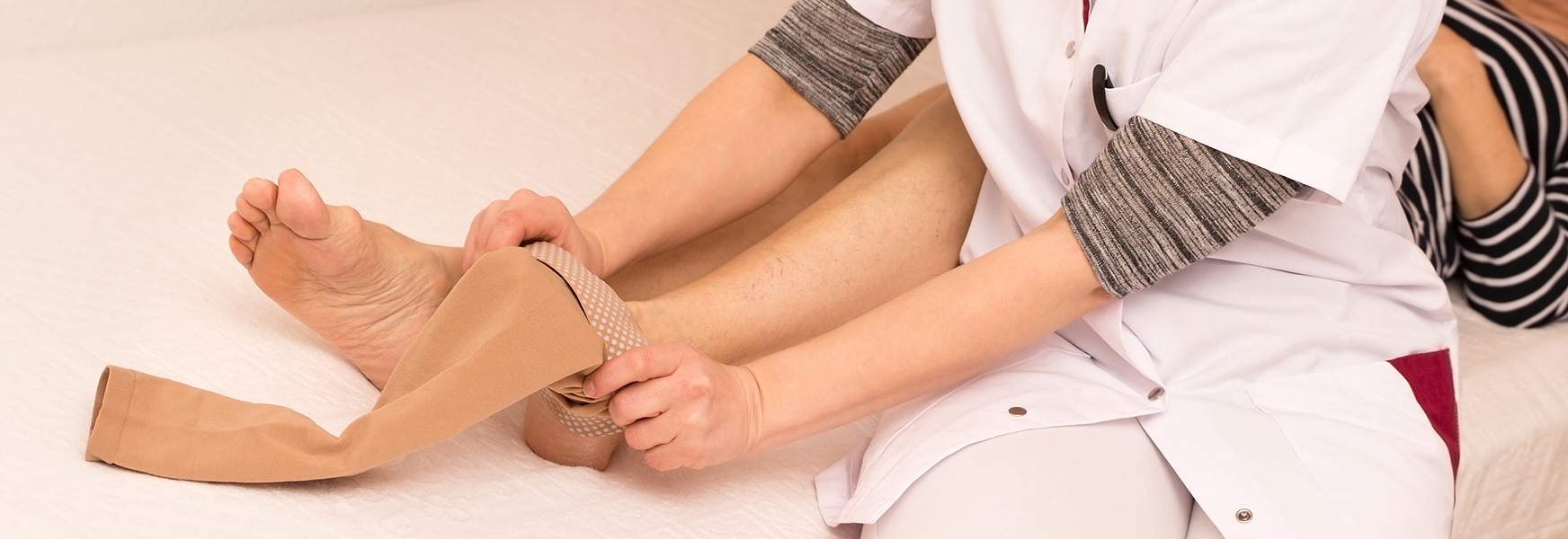The Force Behind Applying Compression Hose

As the pandemic continues its course throughout the country a lot of attention in healthcare has been focused on viral infection prevention and response. This makes perfect sense. These are serious hazards for caregivers; however, they also face the more pervasive issues around ergonomics and musculoskeletal injuries. In recent years, attention has increased drastically around the hazards of manually lifting patients and residents, also known as “dynamic loading.” This has resulted in the development of policies and protocols and a change in the clinical practices emphasizing use of portable mechanical lifts, ceiling lifts, and friction reducing devices. While these efforts are certainly to be applauded, there appears to be less attention on other high-risk healthcare activities that focus on the various types of “static loads” experienced by the caregiver. Examples include bathing and dressing, feeding, and the application and removal of compression stockings otherwise known as TED (thromboembolic disease) stockings. Today we will look at the risk factors and prevention methods for applying compression stockings.
In practice, static loads are forces that are primarily the result of body parts being in the same position for four seconds or longer. For example, standing while bent forward. The further forward you bend while extending your arms in front of you, the heavier the weight becomes on your neck, shoulders and back. This causes muscle fatigue or a “nagging” discomfort. Research has shown healthcare workers spend 20 to 25 percent of their working time in a static posture making static strain the second most frequent cause of musculoskeletal disorders after dynamic strain [lifting/transferring/repositioning]. Studies recommend not to work in static postures for longer than one minute with the upper body bent at the waist.
Literature defines pushing and pulling as exertion of hand force in a horizontal direction. Away from the body for pushing and toward the body for pulling. In addition, pushing and pulling forces can be characterized by the initial force required to start the movement and the sustained force required to finish the movement.
The reason many caregivers find it difficult to apply compression stockings is because of the strong elastic composition of the stocking. This can require the use of “brute force” to hold onto and simultaneously pull up the stocking, particularly to get over the heel and ankle. The compression stocking is designed to be tighter around the ankles with gradually less pressure moving up the lower limbs toward the knees and thighs. The higher the compression, the more push/pull force required to apply the stockings to the leg. While we often think pulling and pushing is less hazardous than lifting, there are limits as to what is considered safe measures for estimating health risks of applying force, pushing, and pulling in work situations.
The following work methods are offered for consideration to prevent or reduce occupational injuries associated with these static loading and push/pull force issues.
- Adjust the bed height or use an adjustable stool/chair when applying compression stockings. Compression stockings are easier to apply and remove if the patient is in a seated position with their hips flexed, such as sitting on a firm bed or sofa.
- Do not continually bend over forward – intermittently stand upright and stretch your back. Check out MEMIC’s Tips for stretching for the Healthcare worker.
- Use a TED hose applicator to reduces friction and lower push/pull forces required to put on and/or remove compression hose. Although MEMIC does not endorse or promote any specific vendor products, many are available such as these from Arion, CompressionStore.com, and Lymphedema Products.
- Consider the use of Intermittent Pneumatic Compression (IPC) devices. An IPC device involves a cuff that wraps around entire calf or a portion of the leg. This cuff is then filled with air, squeezing the leg, before finally deflating. This process helps the body move blood from the legs towards the heart and considered an important preventive measure for blood clots and/or extreme leg swelling.IPCs are most often used in the hospital but are also used in skilled nursing facilities.
Application techniques will vary depending on the type of friction reducing device used. The above devices should be promoted to eliminate the risk factors associated with compression hose application.
References:
A.S. Nicholson, M.M. Ayoub, and Anil Mital. 2004. A Guide to Manual Materials Handling. Taylor & Francis, Inc., USA
Brinkhoff A, Knibbe NE. The ErgoStat Program Pilot study of an ergonomic intervention to reduce static
loads for caregivers. Professional Safety, May 32-39 2003.
Dilks A, Green J, Brown S. The use and benefits of compression stocking aids. Nursing Times. 2005 May 24-30;101(21):32-34.
Garg, Arun et al. “Psychophysical basis for maximum pushing and pulling forces: A review and recommendations.” International journal of industrial ergonomics vol. 44,2 (2014): 281-291. doi:10.1016/j.ergon.2012.09.005
Health Council of the Netherlands. Pushing, pulling and applying force in work situations. The Hague: Health Council of the Netherlands, 2012; publication no. 2012/37E
Knibbe, J.J., and N.E. Knibbe. “Static Load in the Nursing Profession; the Silent Killer?” Work, vol. 41, 2012, pp. 5637–5638, 10.3233/wor-2012-0902-5637.
Dul, J. “A Biomechanical Model to Quantify Shoulder Load at the Work Place.” Clinical Biomechanics, vol. 3, no. 3, 1988, pp. 124–128.
Written by Laurette Wright and Jennifer Campbell
